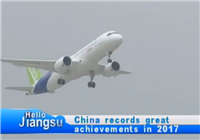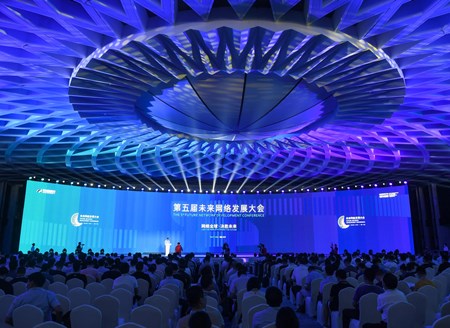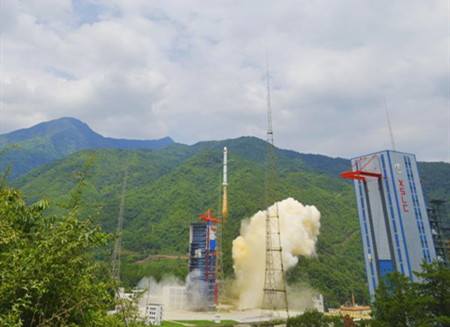China has made many achievements in 2017 in several areas, including aerospace, communication, transportation, economic construction, ecological civilization and technological innovation. This impressive performance has been remarkable to the world. Let’s take a close look at the following major achievements.
China's second aircraft carrier was launched on April 26. The Type 001A aircraft carrier is China's first totally domestic-made carrier based on research from Chinese aircraft carrier Liaoning.
Its launch means China has achieved a major milestone in independent designing and constructing aircraft carriers.
C919 made its maiden flight successfully on May 5. It is China's first self-designed homemade airplane with independent intellectual property rights.
It is a milestone in the Chinese aviation industry and shows China has developed the core technology to build a modern airplane.
C919 has netted 785 orders from 27 Chinese and overseas customers.
"Huiyan", China's first X-ray astronomical satellite, was carried by CZ-4B and launched successfully on June 15, at the Jiuquan Satellite Launch Center. The data from this 2.5-ton Hard X-ray Modulation Telescope will be open to scientists all over the world.
HXMT will help scientists better understand the evolution of black holes and the strong magnetic fields and interiors of pulsars. The satellite will be a useful vehicle for the advancement of high-energy astrophysics in China, and put China among leading nations in X-ray astrophysics and space science.
Fuxing, the latest Chinese bullet train, was developed by China independently. It was first officially launched for the Beijing-Shanghai high-speed railway June 26.
Among the 254 key standards used in the train, 84 percent are Chinese. Its core technologies, including its power supply, operation management and security monitoring, are all homegrown.
The introduction of the Fuxing has also smoothed the road for China to export its high-speed rail technologies and greatly enhanced Chinese soft power.
A 10,000-ton destroyer, domestically designed and produced, was launched June 28.
The type-055 features stronger firepower, higher information capacity and improved capabilities in terms of reconnaissance and early warning, being able to carry more than 100 vertical launch cells capable of firing a range of missiles.
The Type-055 destroyers will make effective missile-defense platforms because they can carry and launch Chinese-made advanced missile interceptors, effectively expanding the country's missile defense network. This is an important milestone in improving the nation's navy armament system and building a strong and modern navy.
Blue Whale 1, the ultra-deep-water semisubmersible drilling rig, is built by China's largest semisubmersible platform manufacturer, China Yantai CIMC Raffles Offshore. It succeeded in collecting samples of combustible ice in the South China Sea on July 29. This is China's first success in mining flammable ice at sea, showing China has mastered combustible ice mining technology.
Blue Whale 1 is the world's most advanced ocean drilling platform design. The platform has the greatest operating and drilling depth in the world, and can operate in deep-sea operations across the world.
Three Yaogan 30-1 satellites were launched successfully on Sept 29, at Xichang Satellite Launch Center. The satellites will be used to carry out technological experiments on electromagnetic environments.
This was the 251st flight of the Long March rocket family.
China's new manned submersible Shenhai Yongshi, meaning “deep-sea warrior”, returned after completing all deep-sea testing in the South China Sea.
It reached a depth of 4,500 meters to test functions and performance during an over 50-day expedition. This means China has become a nation with the ability to produce and test its own massive deep-sea submersibles.
Two third-generation Beidou satellites were launched on Nov 5, at Xichang Satellite Launch Center. This is the first step of establishing a vast positioning and navigation network with global coverage.
Beidou is the fourth navigation satellite system in the world, following the United States' GPS system, Russia's GLONASS and the European Union's Galileo. Beidou has brought huge economic and social benefit in the areas of transportation, fishery, hydrologic monitoring, weather forecast, geodetic survey, intelligent driving tests, mobile phone navigation, vehicle navigation and more.
The Macao port of the Hong Kong-Zhuhai-Macao Bridge, the custom port connecting the three cities with the largest area, is ready for traffic.
Currently the construction of the Hong Kong-Zhuhai-Macao Bridge is in its final phase and expected to be completed by the end of the year.
The Hong Kong-Zhuhai-Macao Bridge is the longest sea crossing bridge in the world, which has profound meaning for Hong Kong, Macao and Zhuhai's economic and social integration. The bridge will cut travel time between Hong Kong and Zhuhai from three hours to just 30 minutes.






